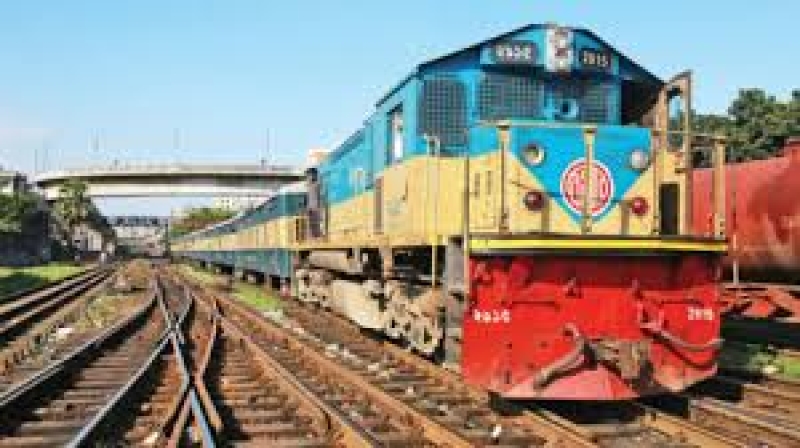- CA Yunus pays homage to Liberation War martyrs on Victory Day |
- Bangladesh capital market extends losing streak for second day |
- Bangladesh celebrates Victory Day Tuesday |
- 'Different govts presented history based on their own ideologies': JU VC |
Billions Invested, Yet Bangladesh Railway Struggles to Stay on Track

Despite a decade of rapid economic growth in Bangladesh, with GDP rising by Tk40 lakh crore and billions in foreign-funded infrastructure investments, the Bangladesh Railway has largely failed to keep pace with this progress. Experts point to poor planning, inadequate coordination, and a lack of investment in key areas as primary reasons behind its struggles.
Over Tk1 lakh crore was invested in the railway sector during this period, but the capacity of the railway service has not expanded in line with the investment. Instead, the state-owned enterprise continues to incur annual losses exceeding Tk1,500 crore, according to sources within the Railway.
While new rail tracks worth billions have been constructed, railway officials report that operations on these tracks are hindered by shortages of locomotives, coaches, and staff—despite a growing demand for services.
Muhammad Fouzul Kabir Khan, adviser to the Ministry of Railways, told The Business Standard, "For years, railway development focused mostly on track construction, but there was little investment in locomotives or coaches. We are now working on procurement."
In the past decade, only 22 pairs of new intercity trains have been introduced, adding capacity for 31,000 passengers. Despite launching more than 10 new commuter trains for shorter distances, over 50 older trains—some more than 50 years old—have been retired.
The Railway’s ambition to become a popular and profitable service provider remains out of reach. Over 50% of its engines and coaches have surpassed their service lifespans. Currently, only about 2,000 coaches and 200 locomotives are fully operational.
Poor Planning and Lack of Accountability
Experts criticize the Railway's development plan as poorly conceived, with investments failing to deliver real results. "They spoke of great potential, but they knew the trains couldn’t operate without the necessary coaches and engines," said Shamsul Hoque, a transportation expert and professor at BUET.
The Railway’s total operational expenditure for the fiscal year 2022-23 was Tk3,307 crore, with revenue of only Tk1,783 crore, resulting in a loss of over Tk1,500 crore. However, a recent report indicates that doubling the Railway’s capacity could increase its revenue to Tk3,650 crore.
Adviser Fouzul Kabir Khan emphasized that passenger services alone do not generate profit for the Railway. "To reduce losses and work toward profitability, we’re focused on improving service quality, increasing freight transport revenue, and upgrading workshops for better maintenance," he said.
Crisis in Operations: Shortages of Locomotives and Manpower
Despite plans to operate 385 trains across the country, only 286 are currently in service. Shortages of engines, coaches, and staff have led to the suspension of 99 trains—50 in the eastern region and 49 in the western region.
There is also a significant shortfall in locomotives for freight services. Currently, only seven engines are available for transporting fuel oil, stones, food grains, and industrial raw materials from the Chattogram Goods Port Yard, far below the demand for 15.
With the Railway's workforce stretched thin, only 23,000 out of the 47,000 sanctioned positions are filled. The shortage is especially acute in the western region.
Md Afzal Hossain, Director General of Bangladesh Railway, acknowledged that converting all routes to broad gauge is a long-term project spanning 25-30 years. He added that a Korean company is under consideration to supply spare parts and assist with repairs to old locomotives.
Path to Increased Revenue: Enhancing Services and Freight Capacity
To boost revenue, Md Shahidul Islam, chief operating superintendent for the Eastern Region, outlined several proposals. Currently, the Railway sells about 200,000 tickets daily, but demand is estimated to be at least 20 lakh tickets per day.
To double the Railway’s capacity and meet this demand, an additional 1,300 coaches, 200 locomotives, and 1,500 staff would be required, potentially increasing annual revenue to Tk3,650 crore.
Proposed changes include increasing the number of coaches on intercity trains from 14 to 18, which could raise revenue by 25%. Adding two extra coaches to 30 train pairs on Thursdays and Saturdays could generate an additional Tk45 crore annually, and running 20 special trains during peak seasons like Eid and Puja could yield Tk120 crore more.
The Railway is also exploring opportunities to boost revenue from freight transport. Currently, only 2% of Chattogram Port’s handled containers are transported by rail, though the port authority is eager to increase this share to 25%. To make this feasible, the proposed Dhirashram Inland Container Depot (ICD) and additional locomotives and personnel would be essential. Such an expansion could generate an additional Tk700 crore annually.
Additionally, the newly constructed ICD at Nimtala Station near Padma Bridge is expected to facilitate the transport of 200,000 TEU containers from Mongla Port, potentially adding Tk300 crore in revenue each year.
Despite billions invested, it is clear that without comprehensive reform and a focus on both passenger and freight services, Bangladesh Railway’s long-standing struggles will continue.

